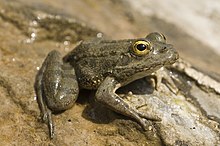Karpathos frog
| Karpathos frog | |
|---|---|

| |
| Pelophylax cerigensis | |
| Scientific classification | |
| Domain: | Eukaryota |
| Kingdom: | Animalia |
| Phylum: | Chordata |
| Class: | Amphibia |
| Order: | Anura |
| Family: | Ranidae |
| Genus: | Pelophylax |
| Species: | P. cerigensis
|
| Binomial name | |
| Pelophylax cerigensis (Beerli, Hotz, Tunner, Heppich & Uzzell, 1994)
| |
| Synonyms | |
|
Rana cerigensis Beerli, Hotz, Tunner, Heppich & Uzzell, 1994 | |
The Karpathos frog (Pelophylax cerigensis) is a species of frog in the family Ranidae. It is endemic to the island of Karpathos, South Aegean Sea, Greece. The Karpathos frog is considered the most endangered anuran amphibian in Europe because its range is restricted to two small rivers in the north part of the island.[2]
Its natural habitats are Mediterranean-type shrubby vegetation, rivers, intermittent rivers, freshwater lakes, intermittent freshwater lakes, freshwater marshes, intermittent freshwater marshes, arable land and ponds. It is threatened by habitat loss.
Distribution[edit]
The species is exclusively found on Karpathos Island in Greece. Confirmed reports identify its presence at two specific localities: two brooks situated near Olympos village in the northern mountainous region of the island. The species exhibits limited range, primarily dwelling at elevations ranging between approximately 200-300 meters above sea level. Its entire known habitat encompasses a single, specific location, covering an extent of occurrence of about 4 square kilometers.[1]
Taxonomy[edit]
Historical reports suggested the occurrence of the Karpathos Frog on Rhodos Island. However, uncertainty shrouds the taxonomic identity of this Rhodos Island subpopulation. Further investigations are required to definitively ascertain whether this subpopulation indeed belongs to the same species as the Karpathos Frog. Consequently, due to this ambiguity, the Rhodos Island subpopulation has not been included in the known distribution maps of the Karpathos Frog.[1]
Diet[edit]
This species preys on beetles, spiders, isopods and various hymenopterans.[2]
Threats[edit]
The Karpathos frog faces a range of threats that could jeopardize its survival and habitat integrity. These threats primarily revolve around habitat loss and degradation, exacerbated by a variety of human activities and potential ecological changes.[1]
The foremost threat to the Karpathos frog is the loss and degradation of suitable aquatic habitats. These challenges are primarily attributed to subsistence agriculture, logging, and infrastructure development. Additionally, over-extraction of water resources and pollution from agricultural, tourist, and domestic sources further exacerbate the habitat's deterioration. Even small-scale habitat changes in the remote areas where the species is known to occur could have detrimental effects.[1]
Freshwater habitats vital to the Karpathos frog face several threats, including excessive water abstraction for purposes like agricultural and livestock watering. These pressures on water resources impact the frog's ecological niche and the availability of its essential aquatic habitats. Potential threats from fires, both initiated by locals for land management and wildfires, become increasingly concerning, particularly in drier conditions.[1]
The species may also be vulnerable to the effects of climate change, although the full extent of these impacts at a local level is not yet fully understood. Changes in temperature, precipitation patterns, and ecological dynamics may have implications for the Karpathos frog's habitat and survival, underscoring the need for ongoing research and monitoring.[1]
References[edit]
- ^ a b c d e f g IUCN SSC Amphibian Specialist Group. (2022) [errata version of 2022 assessment]. "Pelophylax cerigensis". IUCN Red List of Threatened Species. 2022: e.T58567A200683616.
- ^ a b Pafilis, P.; Kapsalas, G.; Lymberakis, P.; Protopappas, D.; Sotiropoulos, K. (2018). "Diet composition of the Karpathos marsh frog (Pelophylax cerigensis): what does the most endangered frog in Europe eat?". Animal Biodiversity and Conservation. 42 (1): 1–8. doi:10.32800/abc.2018.42.0001. S2CID 91586653.

